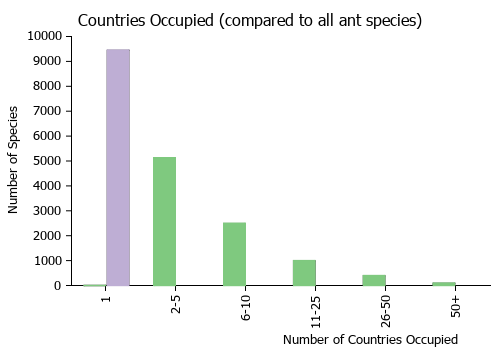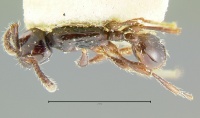Aenictus reyesi
| Aenictus reyesi | |
|---|---|

| |
| Scientific classification | |
| Kingdom: | Animalia |
| Phylum: | Arthropoda |
| Class: | Insecta |
| Order: | Hymenoptera |
| Family: | Formicidae |
| Subfamily: | Dorylinae |
| Genus: | Aenictus |
| Species: | A. reyesi |
| Binomial name | |
| Aenictus reyesi Chapman, 1963 | |
Nothing is known about the biology of Aenictus reyesi.
Identification
A member of the pachycerus group.
Keys including this Species
Distribution
Latitudinal Distribution Pattern
Latitudinal Range: 9.3023° to 9.3023°.
| North Temperate |
North Subtropical |
Tropical | South Subtropical |
South Temperate |
- Source: AntMaps
Distribution based on Regional Taxon Lists
Indo-Australian Region: Philippines (type locality).
Distribution based on AntMaps
Distribution based on AntWeb specimens
Check data from AntWeb
Countries Occupied
| Number of countries occupied by this species based on AntWiki Regional Taxon Lists. In general, fewer countries occupied indicates a narrower range, while more countries indicates a more widespread species. |

|
Estimated Abundance
| Relative abundance based on number of AntMaps records per species (this species within the purple bar). Fewer records (to the left) indicates a less abundant/encountered species while more records (to the right) indicates more abundant/encountered species. |

|
Biology
Castes
Known only from the worker caste.
Nomenclature
The following information is derived from Barry Bolton's Online Catalogue of the Ants of the World.
- reyesi. Aenictus (Aenictus) reyesi Chapman, 1963: 250, fig. 3 (w.) PHILIPPINES (Negros).
- Type-material: 20 syntype workers.
- Type-locality: Philippines: Negros, Cuernos de Negros, Dumaguete, 20.ii.1931 (J.W. Chapman).
- Type-depository: MCZC.
- Status as species: Wilson, 1964a: 477; Bolton, 1995b: 60; Jaitrong & Wiwatwitaya, 2013: 98 (in key).
- Distribution: Philippines (Negros).
Unless otherwise noted the text for the remainder of this section is reported from the publication that includes the original description.
Description
Worker
Wilson (1964) - Syntypes: Worker selected at random: HW 0.73mm, HL 0.82mm, SL 0.62mm. Antenna 10-segmented. Mandibles typical. Clypeus convex, entire, unarmed. Parafrontal ridge about 0.30 mm long. Occiput weakly convex. Basal face of propodeum convex, gently descending to the obtusely angulate junction with the declivitous face. The junction is not surmounted by a ridge and approaches the " evenly rounded " condition of some other members of the genus, e. g. powersi. Subpetiolar process a low lobe lying beneath anterior 1/2 of node. Pilosity sparse; less than 10 hairs break the mesosomal profile. Length of longest pronotal hairs only 0.15 mm.
Antennal "fossae" (the circular, sunken regions median to the parafrontal ridges) microreticulate and subopaque; rest of head shining. Entire mesosomal dorsum shining; entire sides microreticulate and subopaque to opaque. In addition, the mesopleuron is longitudinally rugose. Dorsum of pedicel shining; remainder microreticulate and opaque. Body concolorous dark (almost blackish), rich reddish brown; appendages medium reddish brown.
Type Material
Type locality: Horns of Negros, 450 m, Negros, Philippines
References
- Chapman, J. W. 1963. Some new and interesting Philippine ants (Hymenoptera: Formicidae). Philipp. J. Sci. 92: 247-263.
- Jaitrong, W. & Wiwatwitaya, D. 2013. Two new new species of the Aenictus pachycerus species group (Hymenoptera: Formicidae: Aenictinae) from Southeast Asia. Raffles Bulletin of Zoology 61, 97-102.
- Wilson, E. O. 1964a. The true army ants of the Indo-Australian area (Hymenoptera: Formicidae: Dorylinae). Pac. Insects 6: 427-483 (page 477, see also)
References based on Global Ant Biodiversity Informatics
- Borowiec M. L. 2016. Generic revision of the ant subfamily Dorylinae (Hymenoptera, Formicidae). ZooKeys 608: 1–280.
- Chapman J. W. 1965. Studies on the ecology of the army ants of the Philippines genus Aenictus Schuckard (Hymenoptera: Formicidae). Philippine Journal of Science. 93: 551-595.
- Wilson E. O. 1964. The true army ants of the Indo-Australian area (Hymenoptera: Formicidae: Dorylinae). Pacific Insects 6: 427-483.


